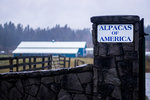

Documents submitted to the state Recreation and Conservation office reveal land sought by the state Department of Fish and Wildlife for possible pocket gopher mitigation is currently the Alpacas of America farm on Old Highway 99 southwest of Tenino.
The WDFW is asking for $3 million from the RCO’s Washington Wildlife and Recreation Program to help them buy the land. Funds from the U.S. Fish and Wildlife Service, Thurston County and the city of Tenino may also be involved as part of a partnership between the parties to acquire the 1,700 acre property for uses ranging from recreation to habitat mitigation.
Owner William Barnett asked for $15 million when he put the property up for sale late last year. The listing cited more than 50 buildings totaling about 120,000 square feet, 1,000 acres of upland forest and 700 acres of lowland pasture.
Barnett has owned the property for more than a dozen years and said he’s most interested in selling it for the purposes of conservation, mitigation and recreation compared to commercial development. He plans to move to a remote property in eastern Washington to raise cattle.
“I’m a biologist and a rancher, so those kinds of things open to the public would be good,” Barnett said. “There could be some flexibility (in price), but that will be part of future negotiations. It’s a long road with a lot of steps involved to sell to the state or federal government.”
Barnett said he’s had a number of informal conversations with WDFW officials about his property, including one earlier this week, and that he’s been contacted by other parties interested in his land for purposes ranging from conservation easements to multi-use development.
State officials aren’t able to engage in serious negotiations until an appraisal is done, which won’t happen until the WDFW finds out whether their grant application was successful, likely sometime in September. The $3 million would go toward the purchase of about 900 acres mostly located on the eastern half of the Alpaca farmland, according to the grant application.
The application materials also state that about 170 of those acres are zoned for agricultural use and could be used for haying or grazing activities that don’t disrupt the habitats of the pocket gophers and Taylor’s checkerspot butterfly, both of which have been officially recognized as endangered species.
Thurston County recently submitted a draft of its proposed Habitat Conservation Plan that would streamline the permitting process related to habitat mitigation for pocket gophers that has frustrated developers for about five years.
Brad Calkins, WDFW Region 6 Wildlife Program Manager, explained that the county and city could partner with his department, monetarily or otherwise, to use a portion of the 1,700 acres as secure habitat for the gophers. He said such a move would not only alleviate some of the burden on landowners in the short term, but aid in efforts to boost pocket gopher numbers to the point of delisting it from the endangered species list.
“This is clearly a partnership effort with the city and county in particular,” Calkins said. “The most likely other source of significant funding we would seek would be (USFWS) money. Another end of the spectrum would be where they, the county and city, purchase, hold and manage a portion of the property. We’re open to any number of arrangements.”
Any portion of the property controlled by the county or the city could be used as a land bank for mitigation credits, similar to carbon offset credits that allow developers and corporations to fund projects that reduce greenhouse gas emissions at a location other than their own.
A letter of support submitted by the Thurston County Board of Commissioners states that “…permanently protected lands, which provide suitable habitat for species covered by Thurston County’s Habitat Conservation Plan (HCP) lessen the amount of mitigation the County and/or its landowners will need to provide over the course of the HCP.”
It goes on to state the county commissioners look forward to working with WDFW to develop a plan for mitigation credits including, but not limited to financial contributions.
“The trigger for a partnership will be if they get the grant and then we start to determine how to partner,” Thurston County Manager Ramiro Chavez said. “There is an opportunity for the county to partner financially because we have a vested interest with the HCP, but the magnitude and scale has yet to be seen.”
The Thurston Economic Development Council and Tenino City Council also submitted letters of support for the grant application.
The letter from Tenino cites city initiatives related to agri-tourism as one reason why it supports the project. Officials there have been exploring the acquisition of a portion of the property where farm buildings are located as part of its efforts to develop an agricultural business park.
Thurston EDC’s letter also referenced the development of a SW Washington Agriculture-Innovation Park, an effort it says involves more than 30 stakeholders and communities in the region.
“I would say there are any number of organizations, governmental or otherwise, that could have come forward to purchase some or all of this property,” Calkins said. “The reason we ultimately elected to pursue it was the potential for public benefit, and we feel that our agency is probably one of, if not the best suited to provide that.”